This should come as no surprise to those who know us, but we don’t follow the BGUTI (Better Get Used To It) principle when it comes to preparing our students for life. The BGUTI principle is the view that education is preparation for the drudgery of living in a world where one seemingly has little control and less options. We prefer to nurture the view of education as preparation for the miracle of living where choices are abundant and the individual thrives while contributing to the ongoing shaping of a dynamic community.
Some parents worry that children attending our schools are “sheltered”, that our vision is “unrealistic”, and that inevitably, our students will have to learn that “life isn’t like Montessori” (although the founders of Google and Amazon would not agree!). On the other hand, we receive frequent feedback about the difficulties parents and students have at other schools, where the BGUTI principle dominates – with resulting emotional, educational and socialization difficulties. Alfie Kohn, author of numerous books on parenting and education, sums it up in his article, Getting Hit on the Head Lessons: Justifying Bad Educational Practices as Preparation for More of the Same:

LGMS students on “Fiery Furnace” Hike at Arches National Park, 2014
…people don’t really get better at coping with unhappiness because they were deliberately made unhappy when they were young. In fact, it is experience with success and unconditional acceptance that helps one to deal constructively with later deprivation. Imposing competition or standardized tests or homework on children just because other people will do the same to them when they’re older is about as sensible as saying that, because there are lots of carcinogens in the environment, we should feed kids as many cancer-causing agents as possible while they’re small to get them ready.
Leading by example, we prefer our community to be brave enough, prepared enough and confident enough to uplift each other, our families, our larger community and eventually the world. Our community began with only two pre-school students in February of 1999. Each year, it has developed and grown to further embody Maria Montessori’s aspirations.
Joyfully looking back on this and previous years with appreciation while Reaching Beyond into next,
Riza Weinstein
“It’s not our job to toughen our children up to face a cruel and heartless world. It’s our job to raise children who will make the world a little less cruel and heartless.” ― L.R. Knost, Author of Two Thousand Kisses a Day: Gentle Parenting Through the Ages and Stages
© Lions Gate Montessori

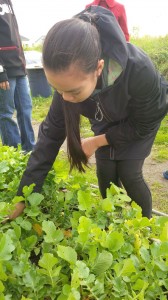 Now that spring has sprung, our adolescent students are resuming their visits to the farm property on Wednesdays. On our first visit this past April 2nd, we had many important tasks to follow up on, as well as new ones to begin! Firstly, we checked on our year-old beehives. Ms. Candice from Mole Hill explained to us what to expect from the bees this spring: they will be leaving the hive more often to explore the surrounding areas, and they will continue building their home.
Now that spring has sprung, our adolescent students are resuming their visits to the farm property on Wednesdays. On our first visit this past April 2nd, we had many important tasks to follow up on, as well as new ones to begin! Firstly, we checked on our year-old beehives. Ms. Candice from Mole Hill explained to us what to expect from the bees this spring: they will be leaving the hive more often to explore the surrounding areas, and they will continue building their home.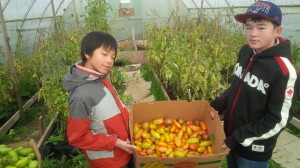 for lunch! And what a delicious treat they were offered by the monks at Thrangu Monastery. We are very grateful to them for extending their kindness and generosity in offering us a wonderful vegetarian meal.
for lunch! And what a delicious treat they were offered by the monks at Thrangu Monastery. We are very grateful to them for extending their kindness and generosity in offering us a wonderful vegetarian meal.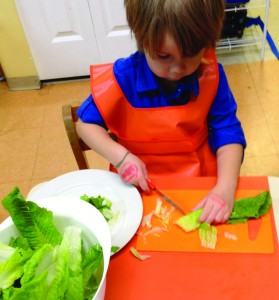 However, before assuming that the child will be able to perform a task, take the time to demonstrate and teach your child how to do things things by her/himself. A careful “presentation” lets your child clearly see how to do something and the technique of use of a specific tool. Have in mind that your movements give your child a stencil to pattern his/her movements after so take the time to handle the objects with care and with respect. For example, show them the way to proper hold a broom (best if you purchase a child-sized broom!) and how to sweep crumbs on the floor or how to wipe up a spill using a sponge or a cloth. Demonstrate how to carefully remove the stem from spinach leaves and place the unwanted parts in the compost bin or how to set a table for dinner. Show them how to sort whites from colours when doing laundry and later how to fold each piece of clothing. Demonstrate how to put one’s own shoes when leaving and hang coats when arriving home. By taking the time to give a practical exhibition of a task and allow your child to perform it at his/her own time, you can help your child become a confident and capable person who contributes to the life in the home. At the same time, your child will be refining his/her fine and motor coordination and feeling a sense of pride.
However, before assuming that the child will be able to perform a task, take the time to demonstrate and teach your child how to do things things by her/himself. A careful “presentation” lets your child clearly see how to do something and the technique of use of a specific tool. Have in mind that your movements give your child a stencil to pattern his/her movements after so take the time to handle the objects with care and with respect. For example, show them the way to proper hold a broom (best if you purchase a child-sized broom!) and how to sweep crumbs on the floor or how to wipe up a spill using a sponge or a cloth. Demonstrate how to carefully remove the stem from spinach leaves and place the unwanted parts in the compost bin or how to set a table for dinner. Show them how to sort whites from colours when doing laundry and later how to fold each piece of clothing. Demonstrate how to put one’s own shoes when leaving and hang coats when arriving home. By taking the time to give a practical exhibition of a task and allow your child to perform it at his/her own time, you can help your child become a confident and capable person who contributes to the life in the home. At the same time, your child will be refining his/her fine and motor coordination and feeling a sense of pride.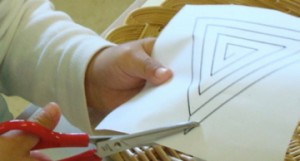
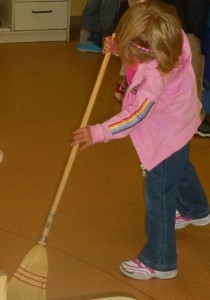
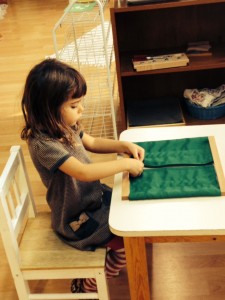
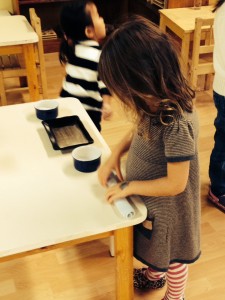 Attractive: Maria Montessori believed that the child must be offered what is most beautiful and pleasing to the eye. The objects tend to come from natural materials such as wood, metal, porcelain, glass, etc. At the same time, the objects must be simple so as to not distract the child from their utility.
Attractive: Maria Montessori believed that the child must be offered what is most beautiful and pleasing to the eye. The objects tend to come from natural materials such as wood, metal, porcelain, glass, etc. At the same time, the objects must be simple so as to not distract the child from their utility.